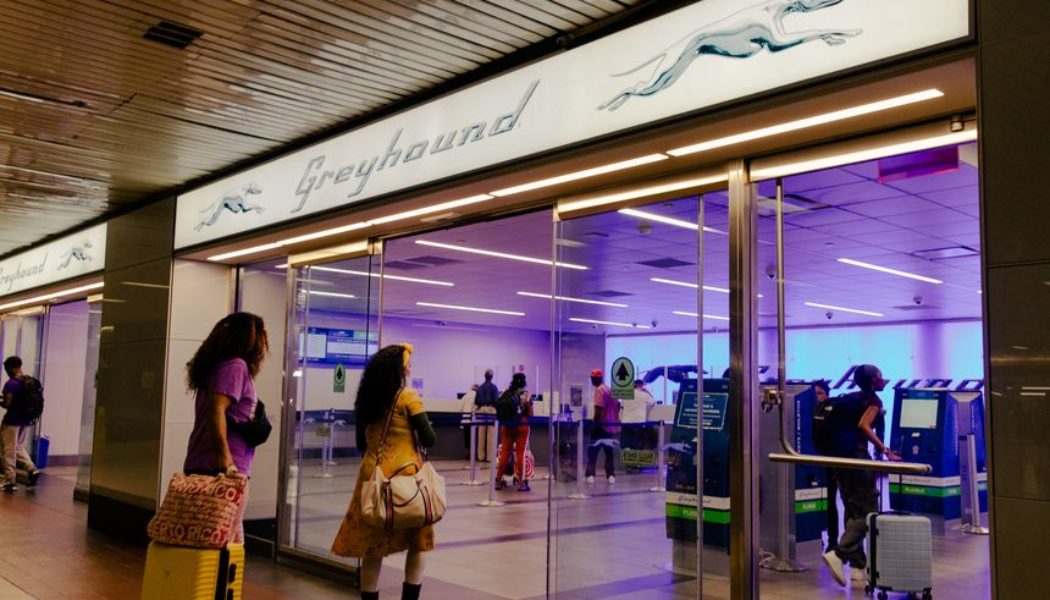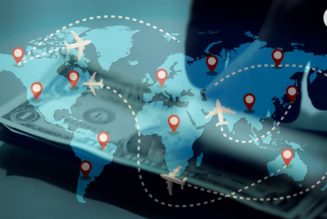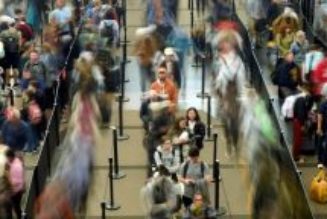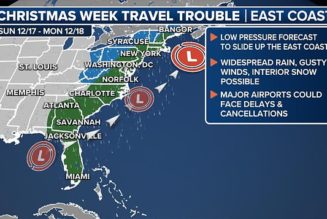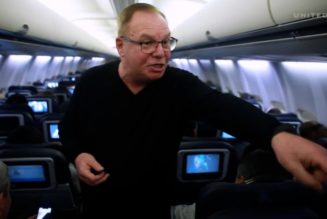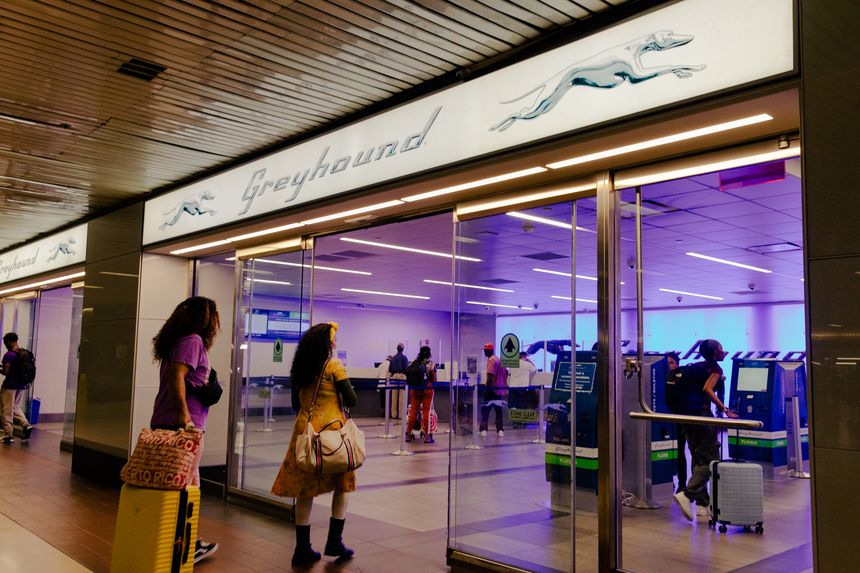
Travelers at the Greyhound ticket counter inside New York’s Port Authority Bus Terminal.
Travelers tired of delays, lost luggage and long lines at the airport are turning to another mode they may never have considered before this summer: a bus.
More U.S. travelers are taking intercity bus trips of all kinds, from no-frills to deluxe options, data from national and regional bus companies show. Riding the bus is often much cheaper than taking a flight, and allows people to evade airport hassles. But trips can take far longer than advertised and disruptions can hit buses as surely as they hit planes.
Flix North America, owner of Greyhound and FlixBus, says ridership jumped 63% year-over-year for the Fourth of July weekend, and 70% over Memorial Day weekend. Greyhound is the largest intercity bus carrier in the U.S. By comparison, air travel rose 11% for July Fourth weekend and the same over Memorial Day, Transportation Security Administration data shows.
Air-travel misery sends people to buses, bus executives say. Alex Danza, chief executive of luxury-motorcoach service Vonlane in Dallas, says his phones rang off the hook when Southwest Airlines melted down late last year.
Another option
Lauren Steltzer, a user-experience designer from Philadelphia, planned to fly home from a trip to Charlotte, N.C., at the end of June.
But her Frontier flight rolled back to the gate after departing for the tarmac, disembarked and was eventually canceled.
A spokeswoman for Frontier says the flight was canceled due to bad weather, and that passengers could take the next available flight or a refund.
Steltzer’s itinerary, booked with an all-you-can-fly pass, was rebooked for three days later. But she couldn’t wait and wasn’t willing to shell out hundreds of dollars for an earlier flight, so she took a Greyhound.
“I thought I would sleep the whole night, but every three hours or so we had to file off,” Steltzer says of the bus. The trip lasted more than 12 hours, and included a two-hour wait at a transfer point. She also says some rest-stop bathrooms were unclean.
But the ticket cost $140—less than a last-minute flight. She says she would make the same trip again.
Traveling by bus isn’t only a Plan B. More road warriors are choosing bus travel from the outset to avoid high fares and airport hassles, says Ramin Shabanpour, a civil engineering professor who studies travel behavior at the University of North Florida. Last summer’s airport snarls spurred travelers to consider buses, he says.
Brandon Alexander made his first Vonlane trip in late May. The 25-year-old brand strategist from Atlanta went to Nashville, Tenn., and back. He enjoyed it enough to try it again twice more. He paid $139 for a one-way trip lasting four hours.
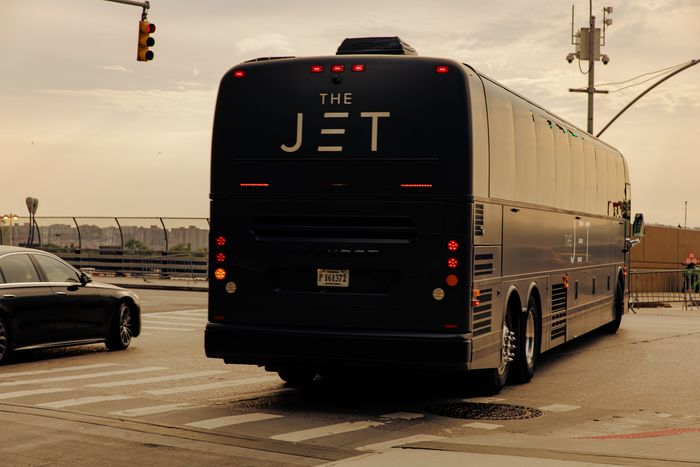
The Jet departs from New York’s Hudson Yards for Washington, D.C.
“I was looking to be underwhelmed in some ways,” he says. But after, he felt almost like he paid too little for the service he was treated to on board. That included extra neck pillows, blankets, eye masks and snacks delivered every 20 minutes.
Plus, he says, door-to-door transit time for the 250-mile trip was equivalent to hopping on an airplane. The difference: no security checks, waits at the gate and lower potential for lost luggage.
Rachel Barcellona, a 26-year-old actress from New York, took high-end bus service The Jet to Washington, D.C., for the first time in June. After one trip, she says she’d choose it over air travel. Her bus trip felt like a first-class flight, she says, but for $99.
Turning a corner
The bus industry could use good news. Since 2020, between 30% and 40% of small motor coach companies in the U.S. have vanished due to fewer travelers in the pandemic’s early days, according to
Peter Pantuso, president of the American Bus Association.
Pantuso says many bus services that survived are short on drivers. Thousands fled the industry for retirement or other work when most travel halted in 2020.
Benjamin Blunt, CEO of Concord Coach Lines in New Hampshire, says his company raised fares between 10% and 15% in the past year, after having kept prices steady since 2018. But travelers have been booking anyway, he says.
That is because even a 50% jump in bus fares takes a $25 ticket to $37.50, Pantuso says.
Recent data suggests that flying has gotten cheaper. The consumer-price index reports the cost of airfare fell 18.9% year over year in June. Overall, bus travel has grown more expensive—by 1.8%—over the same time frame, according to the bus- and train-booking site Wanderu, but there are exceptions. The price for one common trip, from New York to Boston, is down by 22% from last summer, averaging less than $40.
The cheap option doesn’t guarantee smooth travel for passengers. Peyton Grewell, 29, booked a 14-hour Greyhound trip from Indianapolis to Marietta, Ga., in late June for about $80 a ticket. He bought two—one for himself, and the other to keep his row empty.
SHARE YOUR THOUGHTS
When have you opted for a bus over a plane to travel? Join the conversation below.
Grewell’s bus, after a planned stop in Nashville for a transfer, was canceled and the company could only rebook him on a bus that was scheduled to arrive 13 hours later. He had little money on him and no place to sleep, so he ordered a $250 Uber instead.
Greyhound declined to comment on Grewell’s experience.
“I had like 50 pounds’ worth of luggage in the middle of cornfields,” Grewell says. He plans to fly next time.
Sign up for the new WSJ Travel newsletter for more tips and insights from the Journal’s travel team.
Write to Ethan M. Steinberg at ethan.steinberg@wsj.com
